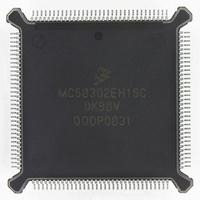MC68302EH16C Freescale Semiconductor, MC68302EH16C Datasheet - Page 415

MC68302EH16C
Manufacturer Part Number
MC68302EH16C
Description
IC MPU MULTI-PROTOCOL 132-PQFP
Manufacturer
Freescale Semiconductor
Datasheets
1.MC68302AG20C.pdf
(4 pages)
2.MC68302AG20C.pdf
(2 pages)
3.MC68302AG20C.pdf
(13 pages)
4.MC68302EH16C.pdf
(481 pages)
Specifications of MC68302EH16C
Processor Type
M683xx 32-Bit
Speed
16MHz
Voltage
5V
Mounting Type
Surface Mount
Package / Case
132-MQFP, 132-PQFP
Controller Family/series
68K
Core Size
32 Bit
Ram Memory Size
1152Byte
Cpu Speed
16MHz
No. Of Timers
3
Embedded Interface Type
SCP, TDM
Digital Ic Case Style
PQFP
Rohs Compliant
Yes
Family Name
M68000
Device Core
ColdFire
Device Core Size
32b
Frequency (max)
16MHz
Instruction Set Architecture
RISC
Supply Voltage 1 (typ)
5V
Operating Temp Range
0C to 70C
Operating Temperature Classification
Commercial
Mounting
Surface Mount
Pin Count
132
Package Type
PQFP
Lead Free Status / RoHS Status
Lead free / RoHS Compliant
Features
-
Lead Free Status / Rohs Status
RoHS Compliant part
Electrostatic Device
Available stocks
Company
Part Number
Manufacturer
Quantity
Price
Company:
Part Number:
MC68302EH16C
Manufacturer:
Freescale Semiconductor
Quantity:
135
Company:
Part Number:
MC68302EH16C
Manufacturer:
PANA
Quantity:
99
Company:
Part Number:
MC68302EH16C
Manufacturer:
Freescale Semiconductor
Quantity:
10 000
Part Number:
MC68302EH16C
Manufacturer:
FREESCALE
Quantity:
20 000
Company:
Part Number:
MC68302EH16CB1
Manufacturer:
Freescale Semiconductor
Quantity:
10 000
Company:
Part Number:
MC68302EH16CR2
Manufacturer:
Freescale Semiconductor
Quantity:
10 000
- MC68302AG20C PDF datasheet
- MC68302AG20C PDF datasheet #2
- MC68302AG20C PDF datasheet #3
- MC68302EH16C PDF datasheet #4
- Current page: 415 of 481
- Download datasheet (2Mb)
stream with the L bit in all Tx BDs cleared, then the byte alignment timing will remain con-
stant.
D.8.11 Initializing Transparent Mode
Full examples of the assembler code required to initialize the HDLC and UART protocols are
given in D.3 MC68302 Buffer Processing and Interrupt Handling and D.4 Configuring A Uart
on the MC68302. A transparent mode initialization follows the same flow as these subsec-
tions except that different values would be used. The HDLC and UART examples also show
writing of the BAR and full configuration of the interrupt controller to allow SCC interrupts,
etc., which are not duplicated here.
The following example shows a step-by-step list of the SCC-related registers as they would
be initialized to create a transparent SCC2 channel in the NMSI mode. The registers in this
example are configured for external loopback with TCLK2 externally connected to RCLK2,
TXD2 externally connected to RXD2, CTS2 a don't care, and RTS2 externally connected to
CD2 (sync). The functionality of this configuration is the same as that shown in Figure D-28.
This example may be easily checked on the ADS302 board, either with the menu interface
software already on the ADS302 board or with user-written software downloaded to the
ADS302 board. The external connections can be made by placing three jumper cables on
row B of the serial bus connector P8: B5-to-B6, B7-to-B8, and B10-to-B11.
MOTOROLA
1. To use SCC2 in the NMSI mode, we need to chose NMSI2 pins instead of parallel l/O
2. The SIMODE register is set to its default setting. This configuration chooses NMSI
3. The SCON register configures the clocking options. Here we chose to generate about
4. The setting shown for SCM2 sets the EXSYN and NTSYN bits, sets the
5. The DSR2 does not need to be written and can be left at its default value since we are
pins. To do this, we write a one to the PACNT register in every bit position that we want
an SCC pin to be active. For this example, we will assume all seven NMSI2 pins are
active.
PACNT = $xx7F
mode on all three SCCs. Actually, all we need is that NMSI mode be selected for
SCC2.
SIMODE = $0000
a 65-kHz clock on the TCLK2 pin with the internal baud rate generator. RCLK2 will
take its input externally; thus, we connect the TCLK2 pin externally to RCLK2. SCON2
= $1200
DIAG1-DIAG0 bits for software operation, and sets the protocol to BISYNC (which is
actually transparent since the NTSYN bit is set).
Since we are implementing an external loopback with the MC68302, the
DIAG1-DIAG0 bits are not set for loopback mode. Setting the DIAG1-DIAG0 bits for
loopback mode causes internal loopback. (To implement an internal loopback, exter-
nally connect only RTS2 to CD2 (sync), set SCON2 to $0200, and SCM2 to $6013.
Later, the very last step is to set SCM2 to $601 F. With internal loopback, RCLK and
TCLK should be directly supplied with the same clock source—either both from the in-
ternal baud rate generators or both from the same externally generated clock source.)
SCM2 = $6033
MC68302 USER’S MANUAL
MC68302 Applications
D-65
Related parts for MC68302EH16C
Image
Part Number
Description
Manufacturer
Datasheet
Request
R
Part Number:
Description:
Manufacturer:
Freescale Semiconductor, Inc
Datasheet:

Part Number:
Description:
MC68302 Configuring the Chip Selects on the MC68302
Manufacturer:
Motorola / Freescale Semiconductor

Part Number:
Description:
MC68302 Design Concept - Expanding Interrupts on the MC68302
Manufacturer:
Motorola / Freescale Semiconductor

Part Number:
Description:
MC68302 MC68302 Adapting a WAN Controller to a LAN Environment
Manufacturer:
Motorola / Freescale Semiconductor

Part Number:
Description:
MC68302 EKB Applications - Power Measurements on the MC68302
Manufacturer:
Motorola / Freescale Semiconductor

Part Number:
Description:
MC68302 Interfacing the MC68020 to a Slave MC68302
Manufacturer:
Motorola / Freescale Semiconductor

Part Number:
Description:
MC68302 MC68302 Software Performance
Manufacturer:
Motorola / Freescale Semiconductor

Part Number:
Description:
MC68302 Evaluating EDX on the ADS302
Manufacturer:
Motorola / Freescale Semiconductor

Part Number:
Description:
MC68302 Design Advisory #1 - MC68SC302 Passive ISDN Protocol Engine
Manufacturer:
Motorola / Freescale Semiconductor

Part Number:
Description:
MC68302, MC68360, and MPC860 Characteristics and Design Notes for Crystal Feedback Oscillators
Manufacturer:
Motorola / Freescale Semiconductor
Part Number:
Description:
Mc68302 Integrated Multi-protocol Processor
Manufacturer:
Freescale Semiconductor, Inc
Datasheet:
Part Number:
Description:
Manufacturer:
Freescale Semiconductor, Inc
Datasheet:
Part Number:
Description:
Manufacturer:
Freescale Semiconductor, Inc
Datasheet:
Part Number:
Description:
Manufacturer:
Freescale Semiconductor, Inc
Datasheet:
Part Number:
Description:
Manufacturer:
Freescale Semiconductor, Inc
Datasheet:











